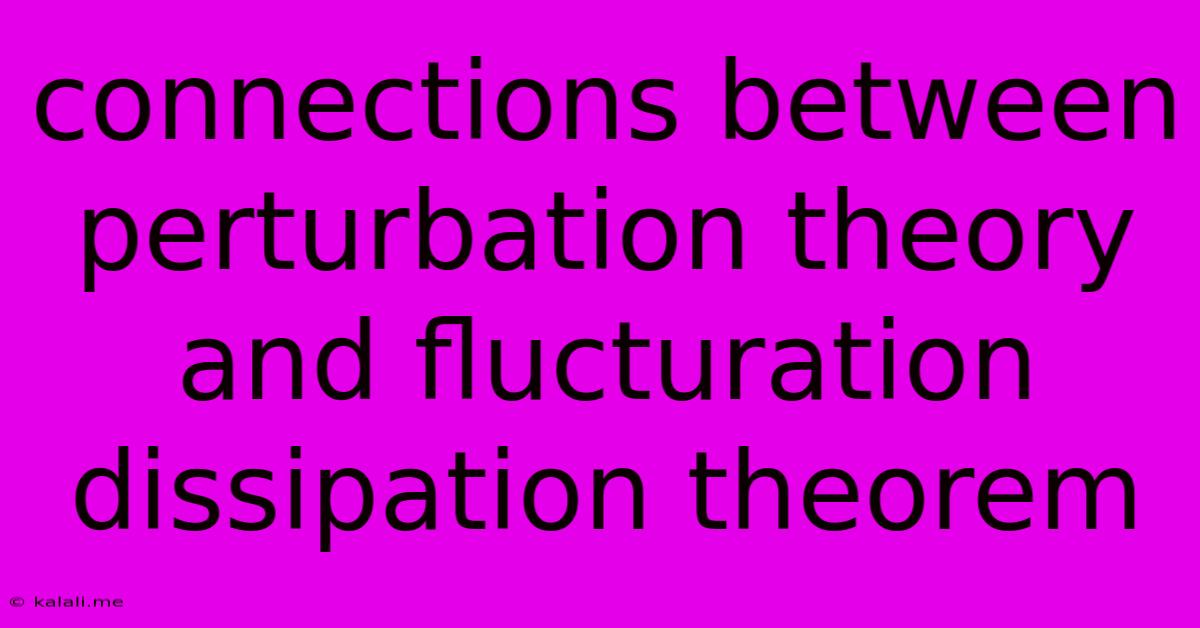Connections Between Perturbation Theory And Flucturation Dissipation Theorem
Kalali
May 31, 2025 · 3 min read

Table of Contents
The Deep Connection Between Perturbation Theory and the Fluctuation-Dissipation Theorem
The fluctuation-dissipation theorem (FDT) is a powerful tool in statistical physics, connecting the fluctuations of a system in equilibrium to its response to external perturbations. This seemingly disparate link is elegantly explained and deeply intertwined with perturbation theory, a cornerstone of many-body physics. This article explores this connection, revealing how perturbation theory provides a framework for deriving and understanding the FDT.
Understanding the Fluctuation-Dissipation Theorem (FDT)
At its core, the FDT states that the response of a system to an external force is directly related to the spontaneous fluctuations of the system in thermal equilibrium. Imagine a system subjected to a small external force; its response (e.g., displacement, change in magnetization) will be proportional to the force. The FDT tells us the proportionality constant is directly related to the auto-correlation function of the fluctuations of the same quantity in the absence of the external force. This is particularly useful because measuring fluctuations is often easier than applying and measuring the response to a controlled force.
Perturbation Theory: The Mathematical Bridge
The connection between fluctuations and response becomes clearer when we employ perturbation theory. We consider a system described by a Hamiltonian, H, to which we apply a small time-dependent perturbation, V(t). This perturbation can represent an external field or interaction. The response of the system is then calculated using linear response theory, a direct application of time-dependent perturbation theory.
Linear Response Theory and the Kubo Formula
Linear response theory assumes the perturbation is weak enough that the system's response is linear in the perturbation. The central result is the Kubo formula, which expresses the response function (e.g., susceptibility) in terms of the correlation function of the unperturbed system:
<img src="data:image/svg+xml;base64,PD94bWwgdmVyc2lvbj0iMS4wIiBlbmNvZGluZz0idXRmLTgiPz4NCjwhLS0gR2VuZXJhdGVkIGJ5IFl1bW9jaCAtIHh0dHA6Ly93d3cueW91bW9jaC5jb20gLS0+DQo8c3ZnIGhlaWdodD0iMzAiIHdpZHRoPSI1MCIgdmlld0JveD0iMCAwIDUwIDMwIiB4bWxucz0iaHR0cDovL3d3dy53My5vcmcvMjAwMC9zdmciPg0KPGcgZmlsbD0ibm9uZSIgZmlsbC1ydWxlPSJldmVub2RkIj48cGF0aCBkPSJNMCAwaDUwVjMwaDUwVjB6IiAvPjwvZz4NCjxnPg0KPGc+DQo8cGF0aCBkPSJNMy41IDguNUwyNS41IDI1LjVMMzc1IDguNSIgc3Ryb2tlPSIjMDAwIiBzdHJva2Utd2lkdGg9IjIuNSIgc3Ryb2tlLWxpbmVjYXA9InJvdW5kIiBzdHJva2UtbGluZWpvaW49InJvdW5kIiAvPg0KPHBhdGggZD0iTTMuNSAyMS41TDI1LjUgNy41TDI3LjUgOS41IiBzdHJva2U9IiMwMDAiIHN0cm9rZS13aWR0aD0iMi41IiBzdHJva2UtbGluZWNhcD0icm91bmQiIHN0cm9rZS1saW5lam9pbj0icm91bmQiLz4NCjwvZz4NCjwvZz4NCjwvc3ZnPg0K" alt="Kubo Formula representation" />
where χ(t) is the response function, and <A(t)A(0)> is the autocorrelation function of the observable A. This equation directly links the response to the system's spontaneous fluctuations. The derivation of the Kubo formula intrinsically uses perturbation theory to treat the effect of V(t).
Specific Examples: Brownian Motion and Magnetic Susceptibility
The FDT finds applications across various physical systems.
-
Brownian Motion: Consider a Brownian particle immersed in a fluid. The FDT relates the particle's diffusion coefficient (a measure of its fluctuations) to its mobility (its response to an applied force).
-
Magnetic Susceptibility: In a magnetic system, the FDT connects the magnetic susceptibility (response to an external magnetic field) to the fluctuations in magnetization.
Limitations and Extensions
While powerful, the FDT has limitations. It's strictly valid only for systems in thermal equilibrium and for linear responses. However, extensions exist for non-equilibrium systems and non-linear responses, though these extensions often require more sophisticated theoretical tools.
Conclusion
The connection between perturbation theory and the fluctuation-dissipation theorem is profound. Perturbation theory, particularly through linear response theory and the Kubo formula, provides the mathematical framework for understanding and deriving the FDT. This theorem bridges the gap between the spontaneous fluctuations of a system and its response to external forces, offering invaluable insights into the behavior of a wide range of physical systems. By applying perturbation theory, we can not only understand the underlying physics but also obtain practical tools for calculating and measuring system properties from readily accessible fluctuation data.
Latest Posts
Latest Posts
-
Why Are Cement Board Cheaper Thn Drywall
Jun 02, 2025
-
Does The Alu Do Anything During Writeback
Jun 02, 2025
-
Why Is The Color Running Out Of My Jeans
Jun 02, 2025
-
To Be Young And In Love
Jun 02, 2025
-
How Do I Make Shelf Smaller
Jun 02, 2025
Related Post
Thank you for visiting our website which covers about Connections Between Perturbation Theory And Flucturation Dissipation Theorem . We hope the information provided has been useful to you. Feel free to contact us if you have any questions or need further assistance. See you next time and don't miss to bookmark.